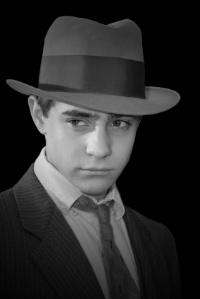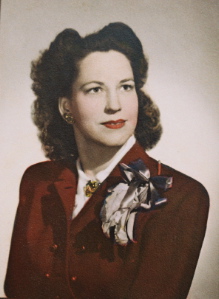Men's Fashion

As the Great Depression came to an end, economics and war altered the style of clothes in the early '40s quite a bit. People stopped caring about the design, and started caring more about the style. People wanted cheap, sturdy clothes that would be light on their wallets and would last for a long time, and no one wanted to be accused of a lack of patriotism by wearing something that made them look like they didn't care about taking the good clothes for themselves and leaving the bad clothes to soldiers. Natural fibers, like cotton, were not used for civilian clothes because they were needed for uniforms, and men's suits lost their vests, pocket flaps, and trouser cuffs. Since most of the men were at war, those that stayed at home wanted to look as serious as possible, though some of the more daring youths wore a "Zoot Suit".
The Zoot Suit was mostly worn by African-American and Mexican-Americans. it was considered unpatriotic and even illegal because its oversized shirts and jackets and baggy trousers were against the standereds of rationing. The fact that it was worn by quite a few gangsters didn't help its reputation.
At the end of the war, the style evolved into the style that is mostly associated with the '40s today. The '40s look mostly consisted of full-cut jackets and a variety of brightly colored shirts and ties. The tie was an essential to the look. Another essential was a hat. The wide-brimmed fedora was very popular in the 1940s. A smart, strong, stylish hat, the fedora was worn by almost everyone.
The Zoot Suit was mostly worn by African-American and Mexican-Americans. it was considered unpatriotic and even illegal because its oversized shirts and jackets and baggy trousers were against the standereds of rationing. The fact that it was worn by quite a few gangsters didn't help its reputation.
At the end of the war, the style evolved into the style that is mostly associated with the '40s today. The '40s look mostly consisted of full-cut jackets and a variety of brightly colored shirts and ties. The tie was an essential to the look. Another essential was a hat. The wide-brimmed fedora was very popular in the 1940s. A smart, strong, stylish hat, the fedora was worn by almost everyone.
Women's Fashion

Most women's dresses in the 1940s were mostly knee length and featured padded shoulders. Women mixed opposing color clothing to make a wardrobe seem more diverse than it was. They made handmade accessories to make it cheaper to have more flashy clothes. Hats made from recycled materials were worn a lot. Clothes were simple and practical in the war era.
After the war when more fabric was available, Paris took the lead in style once more. The "New Look" featured longer lengths and fuller skirts, and used yards and yards of fabric. The women who liked the simplistic look protested, but Paris won.
After the war when more fabric was available, Paris took the lead in style once more. The "New Look" featured longer lengths and fuller skirts, and used yards and yards of fabric. The women who liked the simplistic look protested, but Paris won.
Info from http://www.lovetoknow.com
